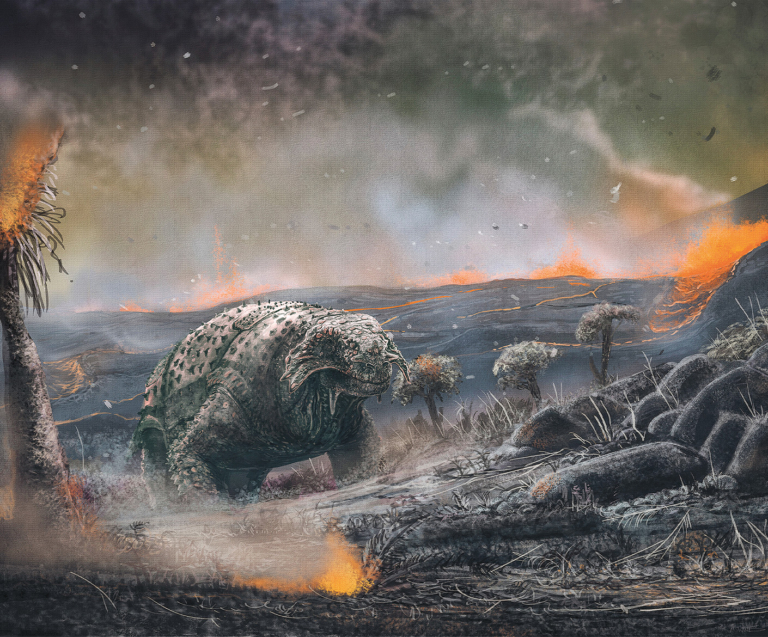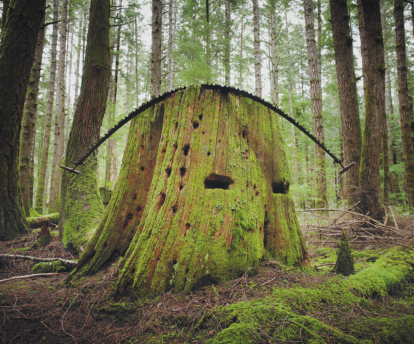When Trees Fall, So Do We
The headline read “Deforestation, Wildfires and Flooding.” Yesterday’s news? No, it was the subtitle of an academic paper regarding the end-Permian Extinction, when life on Earth almost came to an end: more than 90 percent of the animals in the sea and almost an equal number on land went extinct. It is ranked as the most severe of all the biological catastrophes over the last 540 million years since life has flourished on Earth. Many blame mass volcanic eruptions as the killer; others claim the resultant lava cooked adjacent petroleum-bearing rock and the consequent vapors poisoned the seas and land. (The latter resembles the processing of tar sands today.) Or perhaps it was a one-two punch.
Most agree that whatever the cause, greatly increased carbon dioxide levels in the atmosphere had significantly raised the temperature at sea and on land.
The Permian successors of Archaeopteris (the earliest form of tree)—gymnosperms—could not properly photosynthesize due to the crippling heat and the dearth of sunlight brought on by a sky choked with smoke. Just as their predecessors had turned Earth’s landmass into an Eden for the living, the death of most of the world’s trees contributed to an inferno that consumed most everything alive. As the forests perished, so did herbivorous animals of varying sizes from tiny insects to huge reptiles and protomammals, leaving giant insectivore lizards and ferocious carnivores without meat to eat and therefore to starve and die.
Wildfires added to the carnage. With no leaves to protect the soil from the harsh sun, the pelting of raindrops, and blasting winds, and with no roots to tame raging torrents into well-ordered riverbeds, the land gave up its water and soil chock-full of algae to the oceans. Massive erosion not only polluted the seas; it furthered the destruction of life by enhancing the theft of oxygen from them. As scientists concluded, “The drop in O2 concentration across the Permian-Triassic boundary … [is] believed to have been due mainly to a substantial reduction in the geographic extent of lowland forests …” A coal gap throughout Gondwana [an ancient supercontinent] for over five million years attests to just how long the loss of closed forests (forests in which the canopy touches) on Earth persisted. No forests of sufficient size meant no coal. The consequence: little, if any, carbon sequestration, resulting in a great increase in atmospheric CO2 over this period.

A rendering of what a Scutosaurus may have looked like during the Permian extinction event, 250 million years ago. This catastrophe killed more than 90 percent of Earth’s marine species and nearly 70 percent of terrestrial species. Illustration: Mark Witton
With the soil immersed in water, instead of on land, the burial rate of organic matter—the chief mechanism for drawing down carbon dioxide from the sky—prevented sea and land temperatures returning to pre-mass extinction levels for millions of years, slowing to a crawl the reblooming of life on the planet.
These two great events in Earth’s natural history, the rise of forests and their near demise, clearly foretell what to expect in a future forested or deforested world. They provide us with a choice. Do we intelligently care for our lands to restore Earth to the paradise it once was? Or do we repeat the end-Permian extinction by continuing to add carbon dioxide to levels equal to or more than they were 252 million years ago? Doing so destroys one of our best defenses against such a catastrophe by continuing humanity’s war against the forests first portrayed thousands of years ago in the world’s first extant literary work, The Epic of Gilgamesh.

Make love, not war, with wood. An 800-year-old Douglas fir under the touch of a curious human hand. Photo: Jeremy Koreski
As cartographer Tim Robinson waxed poetically, “The axe evolves from stone to bronze to iron to steel. Great woods with all their sighs and cries go down into silence …”
The story of Archaeopteris and its arboreal successors and their subsequent decline by humanity puts, according to Dr. William Stein, a prominent paleobotanist, “a sobering lens on the climatic shifts our planet is undergoing now. Around the world, forests are being cut away, and the ancient carbon left by prehistoric trees—our main source of coal—is being dug up and burned. What’s happening today is the opposite of what happened in the Devonian [Period]. Once again, sweeping change begins and perhaps, ends with trees.”

